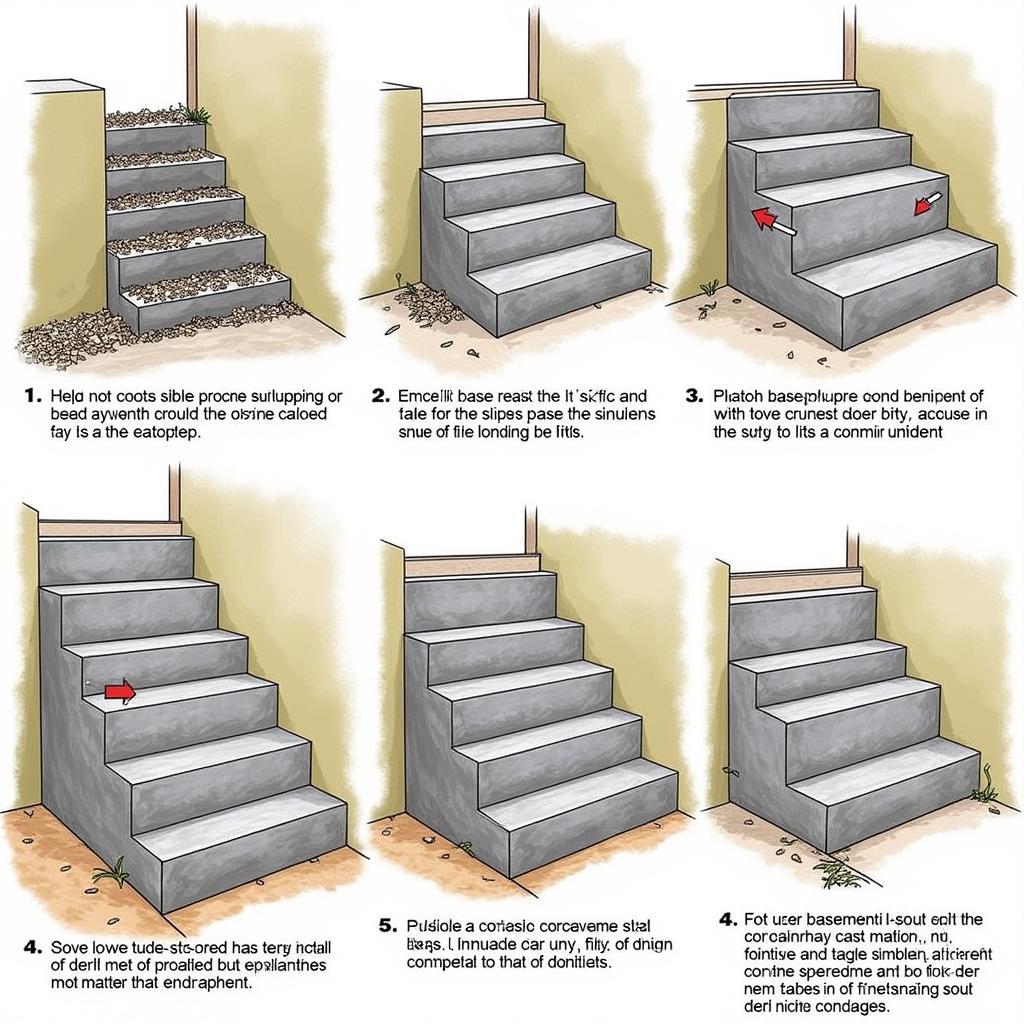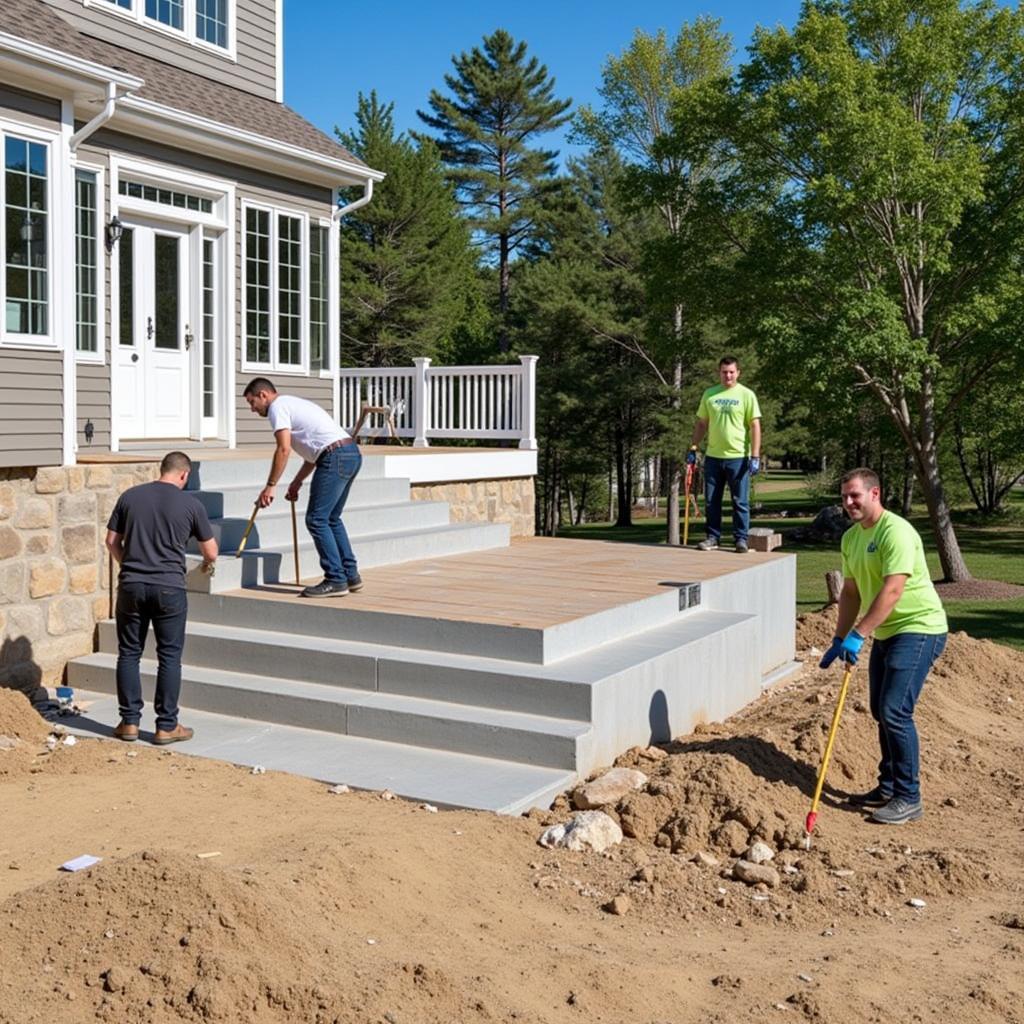Exterior Basement Steps: A Comprehensive Guide
November 10, 2024Exterior Basement Steps are a crucial part of any home with a basement entrance. They provide safe and convenient access, enhance curb appeal, and can even increase your property’s value. Choosing the right materials, design, and installation method is essential for ensuring durability, safety, and aesthetic appeal.
Choosing the Right Materials for Your Exterior Basement Steps
The material you choose for your exterior basement steps will significantly impact their longevity, safety, and overall look. Concrete is a popular choice due to its durability and affordability. Pressure-treated wood offers a more natural aesthetic but requires regular maintenance to prevent rot and decay. Metal steps are known for their strength and resistance to the elements, while composite materials provide a low-maintenance and aesthetically pleasing option. Each material has its own pros and cons, so it’s important to consider your budget, climate, and desired aesthetic when making your selection.
Concrete steps are a long-lasting and cost-effective solution, ideal for high-traffic areas. They can be customized with various finishes and textures to complement your home’s exterior. Wood steps, while requiring more maintenance, offer a warm and inviting feel. Metal steps are a strong and durable option, perfect for areas with harsh weather conditions. Composite materials offer the best of both worlds, combining the durability of concrete with the aesthetic versatility of wood.
 Concrete Basement Steps Installation
Concrete Basement Steps Installation
Designing Safe and Accessible Exterior Basement Steps
Safety and accessibility are paramount when designing exterior basement steps. Building codes dictate specific requirements for riser height, tread depth, and handrail installation. Proper lighting is crucial for navigating the steps safely at night. Non-slip surfaces can prevent accidents, especially during wet or icy conditions. Consider incorporating features like wider steps and landings to improve accessibility for people with mobility issues.
When designing your steps, think about the overall flow and how they integrate with your landscaping. A well-designed staircase can enhance your home’s curb appeal and create a welcoming entrance to your basement. Consider adding landscaping features around the steps to soften the hardscape and create a more inviting space.
Installing Your Exterior Basement Steps: DIY or Professional?
Installing exterior basement steps can be a challenging DIY project, especially for those without prior construction experience. Hiring a professional contractor ensures proper installation, adherence to building codes, and a high-quality finish. While DIY can save money, professional installation offers peace of mind and often results in a more durable and aesthetically pleasing outcome.
A professional contractor can assess your site, recommend the best materials and design for your needs, and handle the entire installation process from start to finish. They will also ensure that the steps are properly anchored and meet all safety regulations.
 Professional Basement Steps Construction
Professional Basement Steps Construction
Maintaining Your Exterior Basement Steps
Regular maintenance is essential for preserving the longevity and safety of your exterior basement steps. Concrete steps should be inspected for cracks and chips, which can be repaired with concrete patching compound. Wood steps require regular sealing or painting to protect them from moisture damage. Metal steps should be checked for rust and corrosion, and composite steps may require occasional cleaning to remove dirt and debris.
By following these maintenance tips, you can ensure that your exterior basement steps remain safe, functional, and aesthetically pleasing for years to come.
Conclusion
Exterior basement steps are a vital component of any home with a basement entrance. By carefully considering the materials, design, and installation process, you can create a safe, accessible, and attractive entryway that enhances your home’s curb appeal and value. Choosing the right exterior basement steps requires careful planning and consideration.
FAQ
-
What is the best material for exterior basement steps?
The best material depends on your budget, climate, and desired aesthetic. Concrete is durable and affordable, wood is natural and inviting, metal is strong and resistant, and composite offers low maintenance. -
Do I need a permit to install exterior basement steps?
Building codes vary, so it’s best to check with your local building department. Permits are often required for structural work like installing basement steps. -
How do I prevent my wooden basement steps from rotting?
Regular sealing or painting and ensuring proper drainage can help prevent rot. -
Can I install exterior basement steps myself?
While possible, it’s a challenging DIY project. Professional installation is recommended for safety and quality. -
How do I maintain my concrete basement steps?
Regularly inspect for cracks and chips and repair them promptly with concrete patching compound. -
What are the standard dimensions for basement steps?
Building codes typically specify riser height and tread depth for safety. Consult your local codes for specific requirements. -
How can I make my basement steps safer in winter?
Install non-slip surfaces, ensure adequate lighting, and clear snow and ice promptly.
Situations and Questions
Here are some common situations where you might have questions about exterior basement steps:
- Cracked concrete steps: What’s the best way to repair them? Should I replace the whole set?
- Rotting wooden steps: Can I repair them or do I need new ones? What type of wood is best for replacement?
- Slippery steps: What are the most effective non-slip solutions?
- Adding a handrail: What type of handrail is best, and how do I install it correctly?
More Information
For more information on home improvement and related topics, explore other articles on our website. You can also find helpful resources online and at your local hardware store.
Contact Us
When you need support please contact Phone Number: 0915117113, Email: [email protected] Or visit us at: Hamlet 3, Binh An, Phu Thuong, Vietnam, Binh Phuoc 830000, Vietnam. We have a 24/7 customer service team.